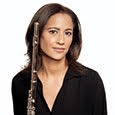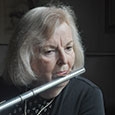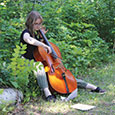Jennifer Grim is an active performer of solo and chamber repertoire and a member of the Zéphyros Winds and the New York Chamber Soloists. For ten years she has taught at the University of Nevada, Las Vegas and will join the faculty at the Frost School of Music at the University of Miami as an associate professor in the fall of 2019.
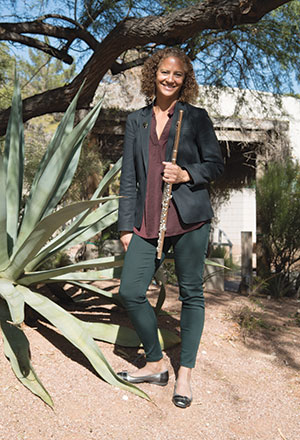
photo by Shahab Zargari
What attracted you to the flute?
My first instrument was the violin, which I started when I was six years old. However, I was frustrated that I couldn’t get a decent sound on the instrument so I quit after only one month. A couple of years later, I heard someone at my school play the flute in a school assembly and thought that it was the most beautiful-sounding instrument. I decided I wanted to try music again. I started flute in school with my classmates and then had private lessons a few years later in fifth grade.
Who were your early teachers?
My first flute teacher was Carole Campbell in Berkeley, California. I studied with her until she told me that it was time for me to move on to her former teacher, Paul Renzi. He was for many years the principal flute of the San Francisco Symphony and also played in New York in the NBC Orchestra under Arturo Toscanini. I learned so much about interpretation from Paul. My lessons always began with orchestral and opera excerpts. He played everything with a certain soloistic flexibility, which I knew was not necessarily the way to win an orchestral job, but these lessons helped me think more imaginatively. While he had me learn the traditional excerpts, I spent more time learning less-familiar pieces. He would tell me stories about playing these pieces in New York. I wish I recorded my lessons with him, to preserve his wonderful anecdotes as well as for his knowledge and pedagogy.
Why did you select Stanford University for your undergraduate degree?
I was a typical overachiever in high school. I played flute in youth orchestra and participated in a lot of other activities. I did not envision going into music when I applied to college. Growing up in California, I wanted to stay nearby for my undergraduate degree and was fortunate to get a good scholarship. My intention was to major in math and take pre-med classes, while still taking flute lessons and playing in the San Francisco Youth Orchestra. For the first two years I spent each weekend in San Francisco, rehearsing with the youth orchestra and attending the SF Symphony concerts. Over time I started to realize that all I wanted to do is practice and found it difficult to see myself going through the many years of studies in order to become a doctor. I eventually changed my major and got a double major in music and psychology. Stanford does not have a music performance degree, so my studies were focused on history and theory, and I received a Bachelor of Arts (rather than a Bachelor of Music) degree.
My teacher at Stanford was Alexandra Hawley. I started studying with her after I became determined to pursue music. She was tough and whipped me into shape. Since I was studying purely for the enjoyment of music until that point, shifting gears into preparing for graduate school was very tough. Hawley is the daughter of Frances Blaisdell, and while I was at Stanford, I played for Frances a few times in masterclasses. She was a warm and generous spirit and what I remember most about my interactions with her are her stories about breaking into the field. She was an incredible role model.
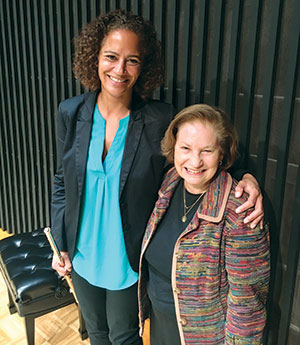
Jennifer Grim and Alexandra Hawley
What led you to Yale for graduate school?
I did not know a lot about music schools on the East Coast, but wanted to live in a different part of the country. Alex Hawley knew Ransom Wilson (they both studied with Jean-Pierre Rampal), and she recommended that I apply to Yale. I felt that Yale was a good fit for me, being that it was a university rather than a conservatory.
I studied at Yale for three years. Two years for my MM degree and the third for my MMA (Master of Musical Arts). During the second year of my masters, I successfully passed the entrance exam for the MMA and DMA program and began my doctoral studies at the end of my second year and into my third year. After my third year, I was awarded an MMA degree, but still had three years to go for my DMA. After students graduate with the MMA, they leave campus and pursue professional activities, such as recitals, masterclasses, etc. After three years away from Yale, I compiled a dossier of my activities including reviews, programs, and letters of recommendation to present back at Yale for approval. This dossier is very similar to a tenure file full of supporting documentation of performance and teaching activities. Once Yale approved my dossier, I was invited back to campus to perform my final doctoral recital and oral examination (both on the same day, one hour apart). I look back on this experience now and realize how similar it was to what we currently do in interviews for academic positions.
Did you always want to be a professor or did you want a life as an orchestral musician?
I always wanted to be a professor at a university. I felt a bit behind in school, since I did not have a music performance degree. Instead, I relied on my strength, which was a knowledge of music history and studies in developmental psychology. Another reason I wanted to go to Yale was the potential to stay and complete my DMA. At Yale I also had my first real experiences with chamber music, and I was hooked. I attended the Norfolk Chamber Music Festival for three summers, formed a woodwind quintet, and played in many chamber music ensembles as a student. My interest in chamber music began at Yale and it continues to be the focus of my performing career.
What chamber music ensembles do you play with currently?
I am a member of the Zéphyros Winds and the New York Chamber Soloists. I joined both groups when I moved to New York City before I finished my DMA. Zéphyros Winds began when all of the instrumentalists were students together at the Curtis Institute of Music. As is the norm with many young chamber ensembles, memberships can change over time. I joined the group in 2001, when the original flutist, Nadine Hur, won the principal flute position in the Knoxville Symphony. For many years we toured several times a year, performing in chamber music venues all across the country. While Zéphyros was a huge part of our musical spirit, it was only one of many groups each of us was involved in, so we never wanted to be a full-time touring ensemble. This worked out very well for us at the time, but as we got older, we wanted more stability. One by one, the members either took on more involved performing opportunities or accepted teaching positions. When I accepted the job at University of Nevada Las Vegas in 2007, I wanted to stay in the group since we were only touring a couple of times a year. This has worked out pretty well, and now the members of the quintet are spread all of over the country. The bassoonist, Saxton Rose is on the faculty of the University of North Carolina School of the Arts; oboist, Fatma Daglar is one of the most sought-after freelancers in Baltimore; Marianne Gythfeldt, the clarinetist is chair of the Woodwind Department at Brooklyn College; and Zohar Schondorf is principal horn of the American Symphony Orchestra in New York.
As a chamber musician, I find it helpful to listen to string players. String quartets are fantastic; the repertoire is phenomenal, and since the process of playing string instruments is more physical than playing flute, I can actually see how they shape phrases and think about colors when bringing out harmonies. The flute is a relatively monochromatic instrument, so we have to put more effort into create subtle timbral changes. I also gain a lot from listening to singers. Often when I work with students on the Marcel Moyse Tone Development through Interpretation, we listen together to the opera arias and discuss ways that singers bring out the words using diction, vibrato, and vowel sounds.
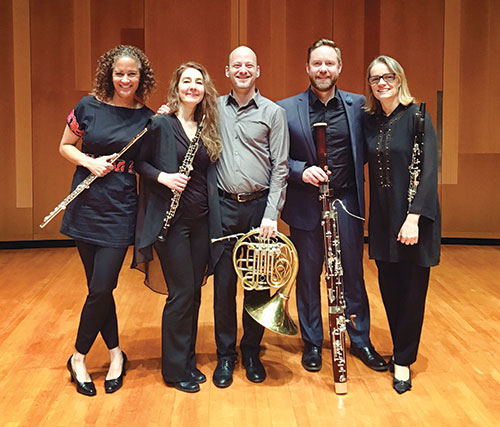
Zephyros Winds
What differences do you see in flute teaching and playing betweem the East and West Coasts?
The only differences I really see have to do with the habitats of each coast. The East Coast is more concentrated, with a lot of players in each major city. In addition, there are classical music concerts every day of the week as well as regional orchestras, chamber music series, and recital venues. The geography of the West Coast is more spread out, and there is not a lot of overlap of flutists in cities. When I lived in New York, I regularly traveled to Philadelphia, Washington DC, and Boston, but I have not visited the neighboring cities (LA, Phoenix, Salt Lake City) nearly as much. The distance between Las Vegas and Los Angeles is notmuch further than New York and Washington DC or Boston, but the lack of easy transportation makes the trip less accessible for students. I would have loved to have my UNLV students be able to travel to Los Angeles to hear the Philharmonic regularly.
What is your teaching philosophy?
It really varies from student to student, but for undergraduates, I focus much more on fundamentals and give students some freedom in selecting their solo repertoire. By the end of their degree, I do try to emphasize major works, so that they are prepared for graduate school.
I begin each lesson with etudes and tone exercises. I like to use Marcel Moyse’s Tone Development Through Interpretation to work on almost everything including tone, breathing, support, developing colors and phrasing, dynamics, note tapering, and more. I try to focus on fundamentals with my new students so that they have a solid foundation. Repertoire is usually mutually decided on with students, and we often do a lot of listening to pieces together.
I also like to have a project each semester with my studio. Students have worked on memorizing, Baroque performance practices, extended techniques, and orchestral excerpts. At least once a year we do a deep dive into Baroque music. One year it was Telemann, while another year they studied the Bach cello suites, and I had a cello colleague give a masterclass to the students.
I have become more interested in Baroque performance practice and bought some Baroque flutes for my studio a few years ago. Every year I introduce some aspect of this music, and several of my students have started learning Baroque flute. Since we have so much Baroque music in the flute repertoire, I feel that it is important to explore more than the few pieces that usually are played.
I took a sabbatical in 2016 to learn Baroque flute. I studied with Stephen Schultz, Christopher Krueger, and Sandra Miller and traveled to Amsterdam to take lessons and observe the teaching of Wilbert Hazelzet, professor at the Royal Conservatory of the Hague. I had always wanted to learn the instrument but could never carve out the time I needed to really get comfortable with the flute. Since coming back from Europe, I joined a chamber ensemble with some other Baroque players in the Las Vegas area and try to perform a few recitals each year to help keep everything in my fingers. Recently, I bought a historic flute made in 1810 that has 6 keys and plays at A=430. I am having fun playing Mozart and Haydn with it. It was refreshing to take lessons again after teaching for so many years.
What are your future plans?
I will begin my new position as the flute professor at the Frost School of Music at the University of Miami next fall. I am so honored to have this opportunity, following the magnificent Trudy Kane, who has had an incredible career as principal flute of the Met before joining the faculty at Frost. I still have several months before I make the move and must admit that I sometimes think that this is all a dream. I will miss my students at UNLV so much. I also cherish the amount of diversity in my current studio.
Do you encourage students to pursue double degrees?
I like students who have another interest, because it helps prepare them for life outside of school. One of the many things that attracted me to the Frost School is their many courses in music business, entrepreneurship, music therapy, composition, commercial music, and songwriting.
What advice do you have for student flutists?
I think that the future for flutists is bright. While the environment has changed in the last 10 years, students are becoming more resilient and preparing themselves to become successful. Mastering the instrument is imperative, but with so many fantastic flutists out in the world, it is not enough. I see students using social media to their advantage, creating profiles and crafting their online image and benefiting greatly from it. I think that it is important for students to have a background in business and entrepreneurship, and more and more college programs are offering these subjects. Students should prepare to become self-sufficient, creative, musicians.
Performing
In addition to the Zéphyros Winds and the New York Chamber Soloists, she has performed with the Chamber Music Society of Lincoln Center, Boston Chamber Music Society, and other chamber artists throughout the United States. She also serves as principal flute of the Mozart Orchestra of New York and the Santo Domingo Festival Orchestra and has given solo and chamber performances throughout the United States and in China, Colombia, Panama, Dominican Republic, Ukraine, the Netherlands, and Spain.
With Zéphyros Winds, Grim recently performed the American premiere of the Wolfgang Rihm Wind Quintet in New York City at the Music in Midtown Chamber Music Series. The ensemble has also held residencies at the University of North Carolina School of the Arts, Skidmore College, University of Maryland, Baltimore County, Brandeis University, Stanford University, San Francisco State University, and Brigham Young University, among others.
Teaching
She is currently an associate professor at the University of Nevada, Las Vegas and has given masterclasses across the country, specializing in both solo and chamber music. Among the institutions at which she has appeared are the Juilliard School, Yale University, Eastman School of Music, Arizona State University, UCLA, University of Arizona, and the Idyllwild Arts Academy.
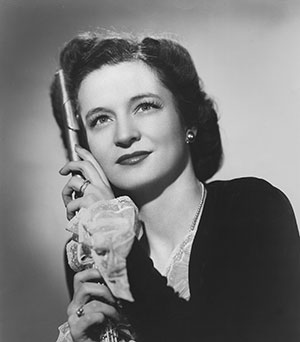
Frances Blaisdell was the first woman wind player accepted at the Juilliard School of Music and as a substitute in the New York Philharmonic. Her teachers included George Barrere, Marcel Moyse and William Kincaid. She was principal flute in the New York City Center Ballet Orchestra, the National Orch-estral Association, the New Opera Company and the New Friends of Music. She taught at the Manhattan School of Music, New York University, the Dalcroze School and the Mannes School of Music. She was married to Alexander Williams, principal clarinet in the New York Philharmonic and of the NBC Symphony under Toscanini. Together they performed in the Blaisdell Woodwind Quintet.
In 1973 they moved to the San Francisco Bay Area where she took an interim position at Stanford University, ultimately teaching there for 35 years until she died at age 97. In 2006 she received the Lloyd W. Dinkelspiel Award for Excellence in Undergraduate Education at Stanford.
